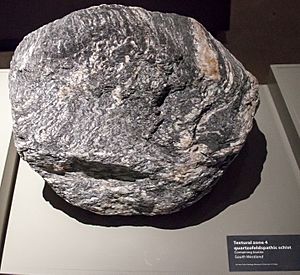Haast Schist facts for kids
Quick facts for kids Haast SchistStratigraphic range: Carboniferous-Jurassic ~320–180Ma |
|
|---|---|

Sample of Haast Schist, containing biotite
|
|
| Type | Metamorphic |
| Unit of | Austral Superprovince |
| Sub-units | Otago & Alpine Schist |
| Lithology | |
| Primary | Schist |
| Other | Greenschist, jade |
| Location | |
| Region | Canterbury, Marlborough & Otago Regions Chatham Islands |
| Country | |
| Type section | |
| Named for | Haast Pass |
The Haast Schist is a special type of rock found in the South Island of New Zealand. It's a metamorphic rock, which means it started as one kind of rock and then changed into another because of extreme heat and pressure deep inside the Earth. This rock unit includes both the Alpine and Otago Schist.
You can find the Haast Schist stretching from Central Otago, along the eastern side of the Alpine Fault (a huge crack in the Earth's crust), all the way to Cook Strait. There are also smaller pieces of Haast Schist in the central North Island. This rock was named after Haast Pass, a mountain pass on the West Coast of the South Island. Geologists divide the Haast Schist into different areas, like the Kaimanawa, Terawhiti, Marlborough, Alpine, Otago, and Chatham schist.
What is Haast Schist?
The Haast Schist started out as different kinds of rocks, mainly greywacke and argillite. These original rocks are called protoliths. Over millions of years, these rocks were buried deep underground. The immense heat and pressure caused them to change, or metamorphose, into schist.
The amount of change a rock goes through is called its metamorphic grade. For the Haast Schist, the grade increases as you get closer to the Alpine Fault. This means the rocks near the fault have been changed much more than those further away.
As the metamorphic grade increases, different minerals appear in the rock:
- First, you might see greenschist, which is a type of metamorphic rock.
- Then, minerals like biotite and garnet start to form. Garnets are often small, reddish crystals.
- Finally, in the most changed areas, you might find orthoclase, another mineral.
How did it form?
The Haast Schist was first brought closer to the Earth's surface during the Cretaceous Period, which was about 145 to 66 million years ago. It was pushed up again more recently during the Kaikoura Orogeny. An "orogeny" is a fancy word for a major mountain-building event. This mountain building happened along the Alpine Fault, which is a very active fault line in New Zealand.
An interesting fact is that pounamu, also known as Jade, can be found in the Haast Schist. It appears as isolated lumps, or pods, in the areas where the rock has undergone the highest metamorphic grades, especially near the Alpine Fault. Pounamu is very important to Māori culture in New Zealand.

